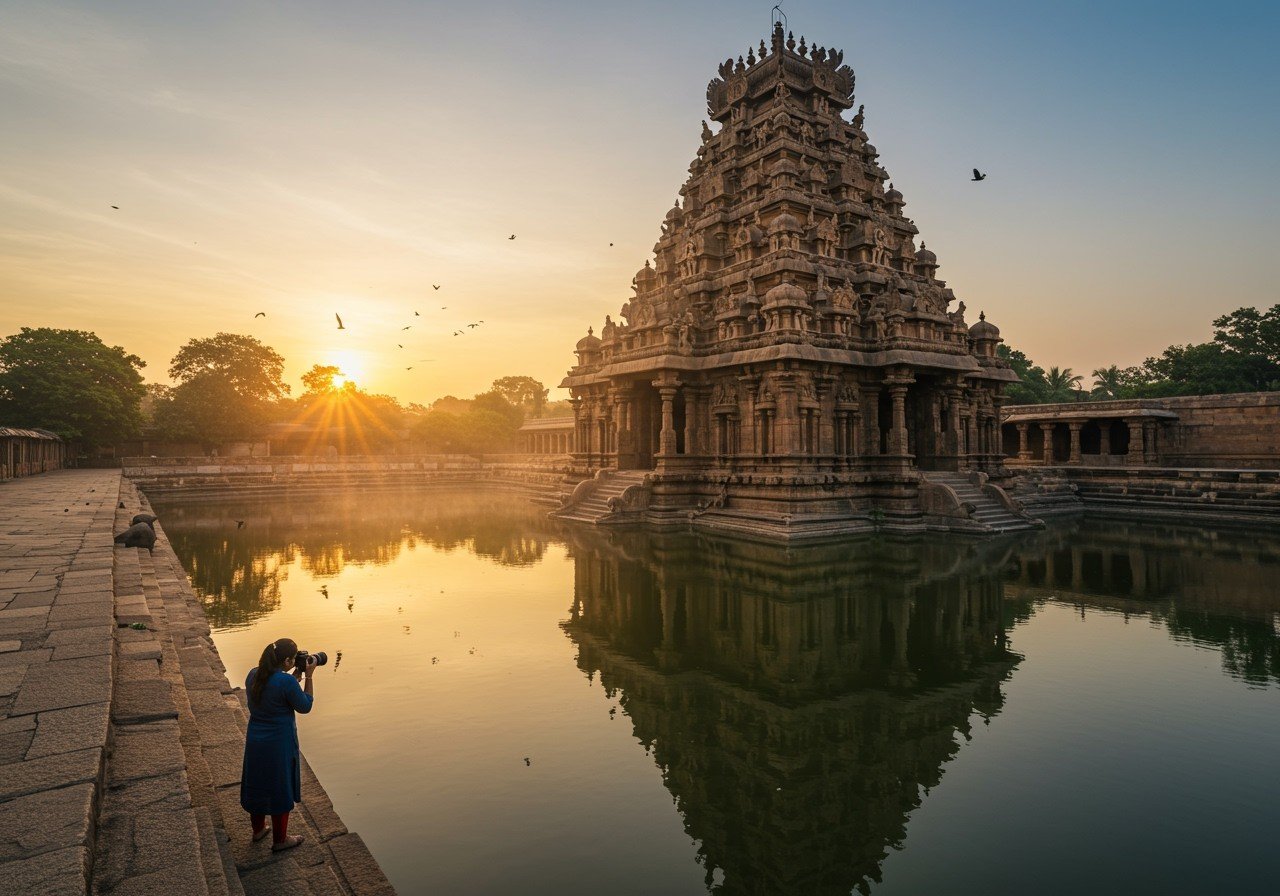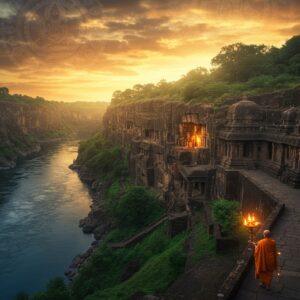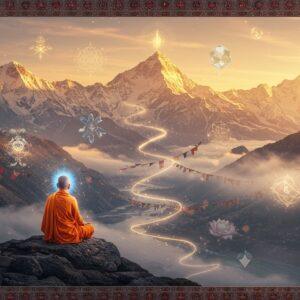
Nachiyar Koil, a town steeped in divine grace and artistic heritage, beckons photographers to capture its essence. This guide unveils the secrets to photographing this sacred space, blending technical expertise with cultural sensitivity.
Delving into History and Significance
Nachiyar Koil, also known as Thirunaraiyur Nambi Temple, holds a special place among the 108 Divya Desams. Dedicated to Lord Vishnu and Goddess Lakshmi (Nachiyar), its ancient origins weave a rich tapestry of spiritual significance. The temple’s unique rituals, passed down through generations, offer a captivating spectacle, inviting photographers to document not just images, but stories etched in time. For a deeper understanding of the temple’s history and significance, you might find valuable resources online or by speaking with local scholars. This knowledge will enrich your photography by adding context and depth to your images.
The Golden Hour: Ideal Time for Photography
The soft, ethereal light of early morning and late afternoon bathes Nachiyar Koil in a warm glow, creating the perfect ambiance for photography. The interplay of light and shadow adds depth and dimension to the intricate carvings and towering structures. Consider planning your visit during festivals like Garuda Sevai, when the temple is adorned with vibrant decorations, offering a unique perspective for your lens. Each season brings its own charm; choose the one that resonates with your artistic vision. For those seeking to capture the tranquility of the temple, weekdays or early mornings offer respite from the crowds.
Framing the Divine: Architectural Details
The architectural splendor of Nachiyar Koil provides a wealth of subjects for your lens. The towering gopurams, with their intricate carvings, tell stories of ancient myths and legends. The Vimanam (temple tower) stands as a testament to architectural prowess, while the sculpted deities offer glimpses into the divine. The Dravidian style, with its ornate pillars and detailed stonework, provides endless opportunities for capturing breathtaking images. A wide-angle lens can help capture the grandeur of the temple, while a telephoto lens allows you to focus on intricate details. Don’t hesitate to experiment with different perspectives and angles to discover hidden gems.
Mastering the Art of Temple Photography
A few techniques can elevate your temple photography. A wide-angle lens helps encapsulate the grandeur of the courtyards, while varying perspectives showcase the symmetry and patterns. Consider using HDR settings to balance the contrasting light, bringing out the rich colors of the temple. Respectful and discreet photography is crucial, especially during rituals and ceremonies. Seeking permission before capturing these sacred moments is a mark of respect and cultural sensitivity.
Composition: Weaving Visual Narratives
Composition is key to creating engaging photographs. The rule of thirds, a fundamental principle in photography, can help you position architectural elements effectively. Leading lines, such as corridors or pathways, guide the viewer’s eye through the image, creating a sense of depth and movement. Adding foreground elements like flowers or lamps can further enhance the visual interest and storytelling aspect of your photos.
Post-Processing: Refining Your Vision
Post-processing allows you to refine your images, enhancing the colors, contrast, and overall mood. Subtle adjustments can bring out the intricate details and create a more impactful visual experience. Remember, the goal is to enhance, not to manipulate, ensuring your final images remain true to the spirit of Nachiyar Koil.
A Detailed Photography Guide for Nachiyar Koil
Nachiyar Koil Temple:
- Architecture: Capture the grandeur of Dravidian architecture. Focus on the towering gopurams, intricate carvings, pillared halls, and sculptures of deities. These elements showcase the rich artistry and craftsmanship of the temple.
- Rituals and Ceremonies: Document the vibrant religious traditions. Capture the daily rituals, festivals, and ceremonies with respect and permission. These moments offer a glimpse into the living heritage of the temple.
- Deities: Photograph the main deities, Nachiyar (Goddess Lakshmi) and Lord Srinivasa. Capture other significant figures within the temple complex, each with their own story and significance.
- Temple Interiors: Explore the play of light and shadows within the temple. Capture the artwork, murals, and the overall ambiance to convey the sacred atmosphere.
Bell Metal Craft (Kuthuvilakku Lamps):
- Artisans at Work: Showcase the skill and craftsmanship of the artisans. Document the process of creating Kuthuvilakku lamps, from molding and casting to finishing.
- Workshops: Photograph the interiors of the workshops, capturing the tools, materials, and the atmosphere of creativity. Show the dedication and passion that goes into each piece.
- Finished Products: Highlight the unique designs and significance of the finished lamps. Capture their beauty and intricate details, showcasing the artistry of bell metal craft.
Surrounding Area & Daily Life:
- Local Life: Capture the essence of daily life in Nachiyar Koil. Photograph street scenes, markets, and interactions between people. This provides context and adds a human element to your photography.
- Landscapes: Explore the natural beauty surrounding the temple. Capture scenic spots, fields, rivers, and other landscapes that complement the temple’s setting.
Photography Tips:
- Respect: Be mindful of religious and cultural sensitivities. Dress modestly and seek permission before photographing people or ceremonies.
- Timing: The best time to photograph is early morning or late afternoon. This is when the light is soft and golden, ideal for capturing the temple’s beauty.
- Equipment: Use a wide-angle lens for capturing the grandeur of the architecture, and a telephoto lens for details and candid shots. A tripod is essential for sharp images in low-light conditions.
- Permissions: Check for photography permits, especially inside the temple. Respect any restrictions and guidelines provided by the temple authorities.
Enhancing Your Experience with Poojn.in
Poojn.in, India’s leading online store for puja samagri, offers a wide range of authentic items to enrich your spiritual journey and photography experience at Nachiyar Koil. We understand the importance of having the right items for your puja and offer a curated selection to enhance your connection with the divine.
Puja Items for Temple Visits:
- Traditional brass lamps for aarti ceremonies, adding a touch of authenticity to your photographs.
- Pure cotton vastrams in appropriate colors, reflecting the traditional attire of devotees.
- Authentic kumkum and vibhuti sets, essential for participating in temple rituals.
- Temple-grade camphor and dhoop, enhancing the spiritual atmosphere of your photography.
For any assistance or guidance on temple-appropriate items, contact us:
Phone: 03369029784
WhatsApp: 9476142738
Conclusion: Preserving Timeless Beauty
Nachiyar Koil stands as a testament to India’s rich cultural heritage. With your camera, you can capture not only the architectural splendor but also the spiritual heart of this sacred space. Approach your photography with respect and sensitivity, and your images will become a bridge, connecting generations and sharing the timeless beauty of Nachiyar Koil with the world.
Explore another divine destination: Kottiyoor Temple.
Plan your visit to Kottiyoor Temple with our comprehensive guide.


